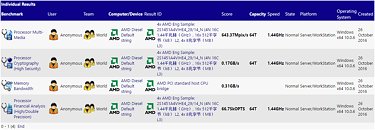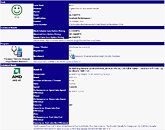Raevenlord
News Editor
- Joined
- Aug 12, 2016
- Messages
- 3,755 (1.18/day)
- Location
- Portugal
| System Name | The Ryzening |
|---|---|
| Processor | AMD Ryzen 9 5900X |
| Motherboard | MSI X570 MAG TOMAHAWK |
| Cooling | Lian Li Galahad 360mm AIO |
| Memory | 32 GB G.Skill Trident Z F4-3733 (4x 8 GB) |
| Video Card(s) | Gigabyte RTX 3070 Ti |
| Storage | Boot: Transcend MTE220S 2TB, Kintson A2000 1TB, Seagate Firewolf Pro 14 TB |
| Display(s) | Acer Nitro VG270UP (1440p 144 Hz IPS) |
| Case | Lian Li O11DX Dynamic White |
| Audio Device(s) | iFi Audio Zen DAC |
| Power Supply | Seasonic Focus+ 750 W |
| Mouse | Cooler Master Masterkeys Lite L |
| Keyboard | Cooler Master Masterkeys Lite L |
| Software | Windows 10 x64 |
If AMD's plans come to fruition, the company's efforts with its Zen micro-architecture will bring it back towards competitiveness with Intel not only on consumer chips, but also on the enterprise segment. While the company's consumer efforts are, by and large, the most visible from a consumer standpoint, with great hopes being pinned on it as a means to inject some much-needed dynamism and innovation in the CPU landscape, the most important vector for AMD arguably stands with the enterprise segment - where margins are usually much greater than in the consumer market.



Recently, a slew of benchmarks on SiSoft Sandra's database hit the web, on an AMD Diesel platform (ie, Naples), identified with the name string 4x AMD Diesel Platform, 2S145A4VIHE4_29/14_N, 16 C. Decoding this, it appears we are dealing with four packages of 16 Cores (16 C), whose configuration appears to be a two-socket (2S), two package, 32-core per socket configuration. As such, we're looking here at 64 physical threads, which ges up to 128 logical if you take into account AMD's implementation of Simultaneous Multi-Threading. The processors apparently come in at 1.44 GHz nominal, 2.9 GHz Turbo core speeds (29/14). The benchmark data also seems to point towards known specifications of the Zen architecture, sporting 512 KB of L2 cache per core, and 4 clusters of 8 MB shared L3 (1 cluster of 8 MB per 4 physical cores).
Check the benchmark scores (some of the low results may stem from benchmark incompatibility, such as the low cryptography scores and such) and as always, any leaked benchmarks must be taken with a grain (or lethal dose) of salt.

View at TechPowerUp Main Site



Recently, a slew of benchmarks on SiSoft Sandra's database hit the web, on an AMD Diesel platform (ie, Naples), identified with the name string 4x AMD Diesel Platform, 2S145A4VIHE4_29/14_N, 16 C. Decoding this, it appears we are dealing with four packages of 16 Cores (16 C), whose configuration appears to be a two-socket (2S), two package, 32-core per socket configuration. As such, we're looking here at 64 physical threads, which ges up to 128 logical if you take into account AMD's implementation of Simultaneous Multi-Threading. The processors apparently come in at 1.44 GHz nominal, 2.9 GHz Turbo core speeds (29/14). The benchmark data also seems to point towards known specifications of the Zen architecture, sporting 512 KB of L2 cache per core, and 4 clusters of 8 MB shared L3 (1 cluster of 8 MB per 4 physical cores).
Check the benchmark scores (some of the low results may stem from benchmark incompatibility, such as the low cryptography scores and such) and as always, any leaked benchmarks must be taken with a grain (or lethal dose) of salt.

View at TechPowerUp Main Site



 No wait, scratch that, there exists 32 core (64 thread) zen opteron, this probably isn't dual socket board at all
No wait, scratch that, there exists 32 core (64 thread) zen opteron, this probably isn't dual socket board at all 